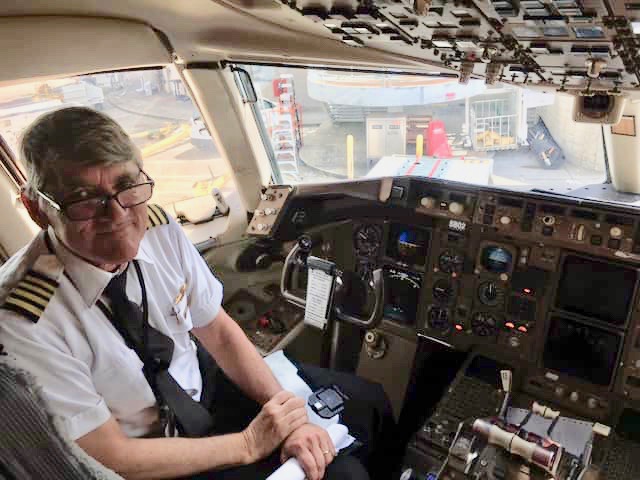SEPTEMBER 30, 2019 – Yesterday we attended a retirement party for our friend Joe Craven, long-time commercial pilot (Northwest/Delta) and former Navy airman. Frankly, I’m sorry Joe is retiring. I always felt safer knowing that he was among the ranks of American commercial pilots.
Whenever we socialize with Cravens, Rich Thomas, a mutual friend of ours, and I inevitably corner Joe to “talk airplanes.” Neither Rich nor I is a pilot, but we love airplanes, and Joe happily indulges us. He’d be a superb instructor, in both classroom and cockpit.
Though we didn’t realize it until decades later, our paths nearly crossed back in Brunswick, Maine. While attending Bowdoin College there, I’d pretend I was flying a Cessna Citation, taking off from a runway outside my dorm, cruising across campus, and landing on a runway outside the library. While Joe was stationed at the Brunswick Naval Air Station (and later Keflavik, Iceland), he was actually flying a Lockheed P-3 Orion “subchaser.” From the top floor of the Senior Center on campus. I used to watch those lumbering “subchasers” take off and land.
From my “pretend” flying, I developed questions. From Joe’s real flying, he developed answers.
Here’s part of an interview I conducted at the retirement party:
How long was your typical patrol on a “subchaser”?
JOE: 10 hours; we flew to where a sub had been detected way out on the Atlantic and dropped sonar-buoys along its path.
What’s your favorite commercial aircraft to fly and why?
JOE: Boeing 757, because it can outperform all other commercial aircraft out there.
What U.S. airport have you found most challenging and why?
JOE: DCA (Reagan National), because you have to follow the Potomac River on approach, then turn hard and land on a very short runway—but what a great view of some amazing landmarks down there!
Based on what you’ve read and heard, would you feel safe flying a 737 Max?
JOE: Absolutely; most American pilots would know what to do if they encountered a problem [with MCAS]—you’d just turn off [MCAS] if you realized it was malfunctioning.
Who are your top three aviator heroes?
JOE: Al Haynes, who, after a broken jet fan blade tore through the hydraulic cables, including both back-ups [which allow control of the aircraft], used engine power alone to steer and land the [United Airlines] DC-10; Sully for his miracle on the Hudson—not for landing on water (most pilots could do that) but for making the decision to do so—for knowing his aircraft well enough to realize he couldn’t make it to nearby Newark or Teterboro or back to LaGuardia; Charles Lindbergh for flying 30 hours across the Atlantic without any navigational equipment [besides a compass].
What did you like most and least about commercial flying?
JOE: Most: landings; least: boredom of long-haul cruising.
What’s next?
JOE: Something related to flying; getting my own airplane, maybe, because I love to fly.
Congratulations, Joe, for a successful career with Northwest/Delta—23,436 hours, 11,718,005 miles, and landing safely after every single flight!
(Remember to subscribe to this blog and receive notifications of new posts by email.)
© 2019 Eric Nilsson

1 Comment
Eric, I enjoyed the interview and the party immensely. Thanks for taking the time to prepare it. I do want to clarify a point about the Boeing 737Max. I don’t want to imply that only American pilots could have figured out what to do. But it would be a huge benefit to any pilot if they had “grown up” flying other Boeing aircraft and there are some developing companies out there who have pilots flying these planes with less time in transport category aircraft. The real problem does not stem from the level of experience of the pilots in these crashes but with a flawed design by Boeing.
Comments are closed.